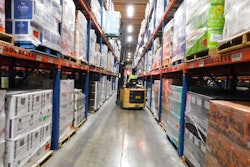
As warehouse technology improves, managers are finding new ways to improve productivity. One aspect of warehouse operations that has witnessed major innovation in recent years is lift truck management, propelled by lift truck telematics and wireless networks, according to an article in the January February Food Logistics Magazine.
Telematics and onboard computers – technologies that are revolutionizing delivery fleet efficiency – are bringing similar benefits to lift truck fleets. Real-time and near-real-time data is unleashing a variety of management reports for all aspects of managing the warehouse, of which lift trucks are one.
The technologies that are expected to have the greatest competitive impact on material handling according to the Material Handling Institute’s 2015 Annual Industry Report are all applicable to lift trucks. The four material handling technologies expected to deliver the greatest competitive impact are: 1) optimization tools, 2) sensors and automatic identification, 3) robotics and automation, and 4) predictive analytics. All four of these are creating new opportunities in lift truck fleet management.
The 2015 Business Trends Survey of the Washington, D.C.-based Industrial Truck Association (ITA) found that 70 percent of lift truck manufacturers believe fleet sizes will decline. Asked to name the leading factors contributing to this decline, the first factor named was improved truck productivity.
On a 1 to 5 scale with 5 being most important, ITA members gave the following reasons for reduced fleets: 1) truck productivity, 4.4; 2) increased availability of fleet data usage 4.0; 2) (tie) warehouse automation, 4.0; 3) price, 3.3; 4) truck durability, 3.0 4) (tie) multiple application truck; 4) reduction in operating cost, 2.6. Manufacturers ranked all of these factors higher in 2015 than in 2014.
Lift trucks represent one of the biggest capital outlays for food and beverage (f&b) warehouses. And as technology brings new efficiencies to lift trucks, it also adds cost. Hence, warehouse managers have to weigh the benefits of improved productivity against the higher investment.
To read the entire article, click here.

















